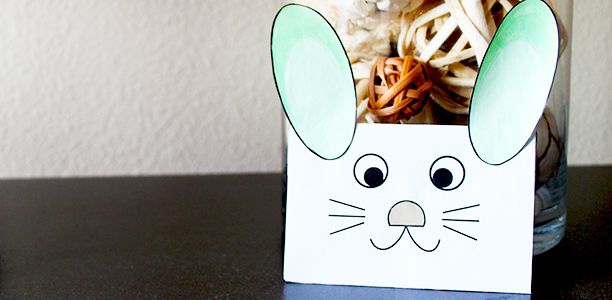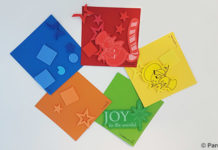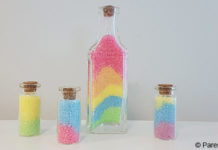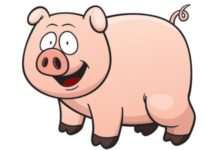Age
4-10 years
Duration of activity
This activity will take about 30 minutes. If you make several envelopes your child will probably get quicker as they make additional cards
Materials/equipment
- Printable Easter Bunny Envelope template – print one page for each envelope you want to make
- Colouring in pencils or felt pens
- Child-safe scissors
- Glue stick
- Optional: wiggly eyes
Cost
You should have all the materials you’ll need for this activity in your child’s activity box- if not they are inexpensive to purchase at a variety store.
Preparation
- Print one or more copies of the Easter Bunny Envelope.
- Get the scissors, pencils and glue stick from your child’s activity box.
- Put down a washable sheet or newspaper to protect the surface that your child will be working on from glue.
What to do
- Show your child the Easter Bunny Envelope template. Explain that when it is cut out and folded up it makes a special envelope for an Easter message or gift.
- Instruct you child to start by colouring in the bunny face (and stick on wiggly eyes if they have them). They may also like to colour the back of the envelope.
- When they have finished colouring, explain that to cut out the envelope they need to follow the solid lines carefully and not cut on the dotted lines. Ask them to use their scissors to cut out the envelope.
- When they have finished cutting explain that the dotted lines are for folding and that the fold they make along each line should go backwards (e.g. so that the folded section is underneath the envelope). This is easiest to do by turning the paper over so the template is not visible then lifting it up from the corner so they can see the dotted line and then folding.
- Ask your child to begin by folding the envelope in half. Help them if they get stuck. Four year olds will probably struggle but by six years most children will be able to fold a straight line on their own.
- When they have folded the middle, open the envelope out again. Turn it upside down and ask your child to fold each of the side sections. These will be used for gluing the envelope together.
- Once all the folds have been made, explain to your child that they need to put glue on the side sections that have been folded, so that they can stick them together and make an envelope. Tell your child to be careful with the glue or they will stick the whole envelope together and won’t be able to put a special message inside.
- Unfold the envelope and lie it flat on the surface for gluing. Help your child use the glue stick to put glue only in the sections that were folded back.
- When all the glue is in place, help them to hold the envelope up while they fold the glued sections back and stick them together. This can be quite fiddly because the glue can easily stick to the wrong part of the envelope.
- When finished, put the envelope aside to dry.
- Colour/decorate the bunny ears and cut them out. Stick them to the front of the envelope to complete the bunny face. Leave to dry.
Tips
- Talk to your child about what they are doing as you make the Easter Bunny envelope. It will give them a chance to learn or practice using new words to describe their actions (e.g. cutting, folding) and to discuss Easter and what it means.
Extension activities
- Ask your child to write a special Easter message for a friend or relative to put inside the envelope. If your child is not old enough to write, get them to tell you what they want the message to say and write it for them.
- Use the envelopes for an Alternative Easter Hunt – they are great for putting clues which your child has to search for to solve the Easter mystery.
Educational outcomes
Fine motor skills
Fine motor skills enable children to do all the fiddly things they need to do with their fingers including folding, picking up small objects, writing, turning pages and cutting. Colouring in the Easter Bunny will help teach them to hold a pencil correctly and control it as they use it. By about four years of age they should be confident using a pencil and holding it correctly. Encourage them to colour the bunny face neatly and stay inside the lines. Children can’t usually colour within the lines until they reach 5-6 years but trying to stay in the lines will be more challenging and require greater control (and develop their finger muscles more).
Cutting pasting and folding are all excellent activities for developing fine motor skills.If you’re using a glue stick, your four year old might struggle but most children will be able to cope by 4-5 years. If you use paste, four-five year olds will generally be able to apply the right amount of glue (instead of using huge dollops that spread out and make a mess, as younger children have a tendency to do) and should be able to keep it pretty much within the area that they’re trying to glue. However, they may still have a bit of trouble spreading it evenly over the envelope folds. Older children will be able to control where the glue does and doesn’t go without much help.
Four and five year olds will probably struggle with folding the envelope and will need help. By six years of age most children have the ability to fold paper in half and quarters and will probably be able to make most of the envelope folds neatly and without help. When they do so they’ll not only be demonstrating the fine motor skills they’ve developed, they’ll also be preparing their fingers to perform more complex and fiddly tasks in the future.
Cutting a straight line might still be two difficult for a four year old, although they’ll almost certainly be able to cut out the shape of the envelop roughly. By five years most children can cut straight lines and corners, but many will still have a bit of trouble cutting the inside corners near the middle fold of the envelope. They’ll benefit from having a go as it will require them to exercise more control over the scissors, however they might need your help. From about six years onwards children should be able to do all the cutting, even the fiddly bits independently and will increase their precision as they get older and have more cutting practice.
Communication and social skills
Social and communication skills are best learnt young but they’ll be used throughout life. They allow children to make friends, communicate effectively and understand instructions as they grow up and enter the big wide world around them. As with most things, practice make perfect- as you communicate with your child about what they’re doing and discuss Easter, they’ll be getting the practice they need to master the art of communicating and socialising. Four year olds have a tendency to ask lots of questions, so expect them to ask you questions starting with why or how (e.g. how do I fold it neatly or why are the Easter Bunny’s ears so big). Listen and answer when they speak so they learn from your example how to communicate politely and effectively.
Easter has many different meanings and by talking about them your child you’ll be helping them understand the world and how the people in it can be the same or different. Four-six year olds will have an opportunity to better understand culture and how people from different cultures hold different beliefs. They’ll also come to better understand the community and their place in it, for example that communities include people with similarities and differences. It will help them understand that being different is okay and everyone has a right to believe what they do. It will give them an opportunity to develop and express their own ideas about Easter and anything else you discuss. They’ll also get practice using the words they need to express their feelings and opinions.
Language and literacy skills
Listening and speaking also help children develop their English language skills. If you speak a second language, using this as well as or instead of English will help them develop the ability to speak two languages, and also an understanding that English is one of many languages people in Australia and around the world use to communicate. Literacy skills will also develop when children read printed words or have them read aloud, and when they put their own pen to paper to write text (even if it is an illegible scribble, having a go and showing an interest is an important step in literary development for younger children.
If you have a four-five year old you’ll probably notice them:
- Use more complex grammar and speaking in proper sentences. For example they will start to use words like ‘a’, ‘an’ and ‘the’; instead of pointing and saying, ‘bunny’ they might say, ‘There is an Easter Bunny on the envelope.’
- Attempting to read and using their finger to point to different sections of words as they sound them out and trying to pronounce them. For example they might try to read the instructions on the page.
- Asking something like, ‘what does this word say?’ when they come to something they can’t read.
- Write their name at the bottom of their Easter message, although most will need you to write the body of the message for them.
- Your six- seven year old will demonstrate their increasing language and literacy skills by:
- Composing the text of Easter messages and writing the messages themselves.
- Understanding that the way they write the message on the card differs from the way they would express the same feelings in speech.
- Using upper and lower case letters and simple forms of punctuation like full stops. However they may not use them consistently yet, for example at this age your child might put in a full stop but forget to follow up with a capital letter.
- Using a range of words that express their feelings and understand how these words differ from the words they use to convey facts. For example in a letter to grandma they might express their feelings by writing ‘I love you and I miss you’ and convey facts like, ‘I am on holidays from school because it is Easter.’
By eight years your child will probably be:
- Using upper and lower case letters correctly, for example consistently using upper case letters at the start of sentences, when writing a person’s name or a pronoun (e.g. the name of their school).
- Spell many words correctly, including words which have unusual spellings, for example those including silent letters (e.g. Easter) and those in which the letter sound different to what they typically do (e.g. when writing to Aunty Cheryl, they do not spell her name Sheryl).
- Write neatly and legibly in unjoined letters. Most kids are not able to writing in joined letters (running writing) yet.
Nine to ten year olds will be at the stage where they:
- Understand more complex grammar rules, for example that ‘doing words’ like cutting are verbs and words that describe things like envelopes are nouns. They will understand a variety of ways of combining nouns and verbs to make sentences.
- Understand new forms of punctuation, for example to use quotations marks to indicate when someone is speaking. For example in a letter to their friend they might write I said, “I want Billie to come and visit for the Easter holidays.”
- Are able to write in running writing, keeping their letters neat and of a similar size.
- Work out how to spell complex words by applying spelling rules.
Persistence and problem solving
Cutting and folding the template to make an envelope is fiddly and children will need to persist and solve problems as they do it. While demonstrating that they already know a thing or two about persevering and working out problems, they’ll also be further developing these skills.
References
- Virginia Early Childhood Development Alignment Program. Milestones of child development- A guide to young children’s learning and development from birth to kindergarten. 2009. (cited 26 July 2013). Available from: (URL Link)
- Queensland Health. Physical and cognitive milestones. 2007. (cited 31 July 2013). Available from: (URL Link)
- Australian Curriculum and Reporting Authority. Australian Curriculum- English. Undated. (cited 2 October 2013) Available from: (URL Link)
- Andrews M. General Categories of Fine Motor Development. Michigan State University Extension. UNDATED. (cited 28 March 2014). Available from: (URL Link)




 (3 votes, average: 3.67 out of 5)
(3 votes, average: 3.67 out of 5) 






